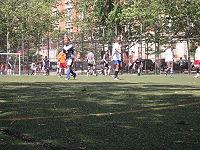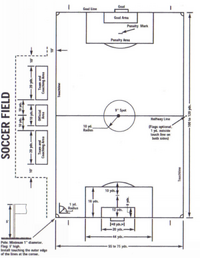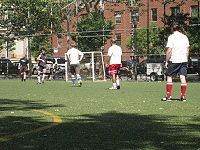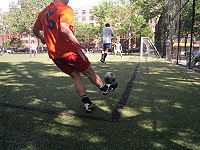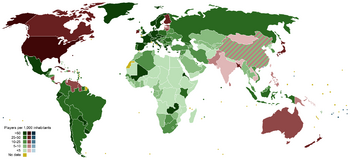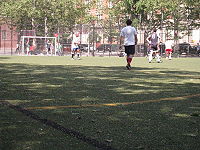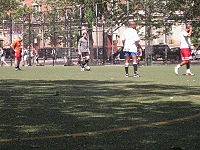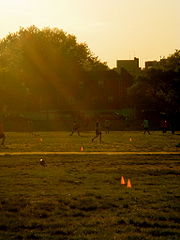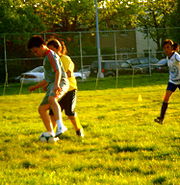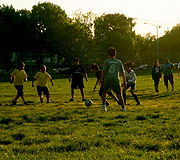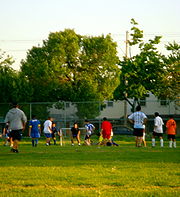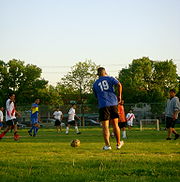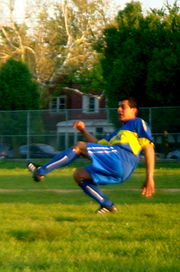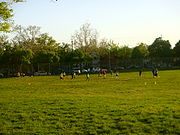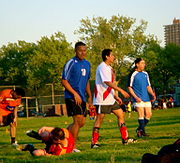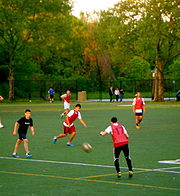From The Peopling of New York City
Contents[hide] |
Soccer
Background/History
Before the modern game of soccer came into existence, there were ancient sports that resembled soccer. The Chinese played T'su Chu or Cuju, in the 3rd century B.C., which was played with a hair-filled leather ball. The Greeks and Romans were also believed to have taken part in a variation of the sport. The Romans played harpastum, which was similar to rugby. The ancient Romans were forced to play everyday, to help them stay well conditioned. Therefore, these games helped prepare and train the fighters for battle. The game eventually evolved into modern day soccer, and spread around Europe and the world. In the early 14th century, King Edward II of England banned the game because soldiers were playing soccer rather than practicing archery. However, the sport would return to England. In an attempt to standardize the varying forms of the game, the Football Association in England established a set of rules. These rules were adopted in the 1860’s and have become the standard for the modern game of soccer. Soccer, which is more commonly referred to as football in other countries, has become the most popular sport in the world. While the exact origination of soccer is disputed, it is possible to see how the sport has developed from the many ancient variations to the modern day game.Rules of the Game
The official sport of soccer consists of 17 rules listed in the “Laws of the Game”. Soccer is played between two teams of eleven players each and one ball. However, this number excludes substitutes. The equipment consists of shirt, shorts, socks, shin guards, and cleats. The uniform must be the same for the entire team, except the goalie, whose jersey must stand out from the other players. There is also a referee on the field in charge of enforcing the rules of the game, who is assisted by two linesman and a fourth official. The objective of the sport is to score a goal by getting the ball past the goalkeeper, and into the net. The team with the most goals wins the game, and depending on the type of match, an equal number of goals could result in either a draw, or extra time and penalty shots. During game play, the goalkeeper is the only player allowed to use his or her hands (only in the penalty area), while anyone may be able to take a throw in. Dribbling involves movement of the feet, however, they may also use their chest, head, or thigh. The only restrictions are using hands and arms, which would results in a handball, awarding the other team possession. While tackling is permitted to win back possession, there are restrictions. Offenses can be awarded at the referee’s discretion, as well as a yellow card (caution) or a red card (ejection). A foul in the penalty box results in a penalty shot, which is a free kick taken from twelve yards out with only the goalkeeper between the goal and the shooter. There is one limitation regarding movement on the pitch, which is the offside rule. Usually, the offside rule is the more difficult rule for beginners to understand. The rule states if a player is in an offside position, he may not be involved in the play once the ball is played by a teammate.Popularity of Soccer Around the World
There are many reasons for the worldwide popularity of soccer. Similarly to cricket, the modern game of soccer originated in England. From there, soccer would eventually spread throughout Europe and eventually reach other parts of the world with great success, mainly South America. In these countries, soccer grew to become the nation’s most popular sport, in part due to tradition. Soccer has created intense rivalries in which fan's pride are put to the test. Around the world, soccer fans crowd the stadiums to cheer and sing for their teams. No other sport's fans show the same passion as they do for soccer. Another reason for soccer's popularity around the world revolves around economic factors. Regardless of economic or social standing, soccer is an accessible sport. In poor economic countries, soccer is the sport pursued by most children. As a result, third world countries are more inclined to play soccer. Parks, streets, and any other open space provide a suitable environment to play. The only piece of equipment required is a ball, but even that can be replaced with available materials.
Contrary to popular American sports, soccer results are usually low scoring. Soccer has few highlights during the game, but it is during those few minutes of brilliance that can decide a match. However, fans of the game can recognize and appreciate the strategy involved in soccer. Soccer is the ultimate team sport, in which tremendous skill and strategy is involved. Fans do not simply notice the goal scored, but also the passing, the runs, and the dribbling that created that goal scoring opportunity. They also applaud the defensive prowess of a player to steal possession of the ball and to make game changing tackles.
Popularity of Soccer in the United States
Shown in the map to the right, soccer is the number one sport in many countries throughout the world. However, the sport has struggled to gain significant popularity in the United States. There are many theories behind the inability for soccer to dominate the sports industry in the America. One of the major reasons for this lack of popularity is due to the lack of finances. Soccer has not generated anywhere close to the amount of money that the other major sports have. Also, the salaries of MLS (Major League Soccer) players are far inferior to athletes in other sports. Previously, MLS was only spending around $30 million dollars on their TV deal, compared to the billions spent by NFL and NBA. Another opposition to soccer is that there are many other sports to choose from. Furthermore, "most Americans see the sport as a slow-paced, low-scoring, boring game." Americans tend to feel that soccer is representative of European cultures rather than American culture and history.
While football, basketball and baseball have remained as the top sports in the United States of America, soccer has become increasingly popular in the US throughout the 90's. Compared to these other sports, MLS, which is the soccer league of North America, is very young. Initially, soccer was popular in areas with large immigrant populations, such as New York, but has gradually gained interest across the country, due to the expansion of the MLS and most significantly the success of the US national team. Recently, TV networks such as ESPN, FSC, and GolTV have exposed soccer to larger audiences. By airing the world's greatest soccer competitions like the World Cup, the Euro, the Champions League, as well as league games and many other cups, Americans have become increasingly interested in the sport.
Soccer in New York City
New York City contains a large and diverse immigrant population, who prefer soccer compared to many other sports. The biggest and fastest growing minority, Latino Americans, live in urban communities where it is difficult to find a nice place to play a game of soccer. Since they lack the money for organized sports, immigrant groups gravitate towards soccer. Soccer is a very inexpensive sport to play because the only thing needed is a ball, making soccer extremely easy to play at the park and a reason for its popularity amongst immigrants.
Recently, the game of soccer has become a prominent part of recreational parks around New York City. Of all the soccer players seen around the city, people of Latin and South American descent comprise a large number. Passing a field where a game is held, one can hear Spanish words and phrases, shouted from one player to the next in the heat of the game. The ethnic composition of the players is related to the demographics of the neighborhoods in which the parks are located. This is particularly true of Kissena, Ferry Point, and Columbus Parks. However, this isn't to say that Latin and South Americans are the only ethnicities that are seen participating in soccer games. Arabs, South Asians, Greeks, Russians, and Poles are also active soccer players, but have not been found playing in numbers as considerable.
The prominence of Latin and South Americans playing soccer in New York City’s parks can be attributed to the popularity of the sport in the players’ home countries. El Salvador, Chile, Mexico, Uruguay, and Ecuador (countries with significant numbers of immigrants in New York City) consider soccer as their main sport and have participated in the FIFA World Cup, and some have also qualified for the 2010 tournament. As a result, as the people from these countries immigrated to New York City, they brought the sport with them, making the game noticeable in parks around the city.
Although there is a set of rules for the sport, the players in NYC parks have made adaptations to the game. Because of the casual park setting, there is no need to adhere to the formal rules of the game; additionally, the players, usually part of the working class, do not have the time or the resources to provide all the necessary materials for a "proper" game, especially when they play for a few hours on a daily basis. Some of the alterations that have been made include: 11 players on each team, a disregard for some rules, such as offsides and petty fouls, a lack of goals, which are usually improvised with garbage cans or cones, and no referees. Despite these modifications, the games are nonetheless taken very seriously and the players are very competitive. This can be noted by the signals the teammates give to one another, the shouts (mostly in Spanish) to direct a teammate on what to do, and frustration when a goal is missed or when the opponent scores a shot.
"Soccer's growth will mirror the increase in this nation's immigrant population. American football may always dominate, but even this World Cup you're seeing bars and cafes filled with people of different ethnic backgrounds watching together. It's a small thing but significant." Soccer has long been viewed as the sport of foreigners, and to this day immigrants have expressed their interest in the sport. Since soccer has yet to reach its peak in popularity in the US, it would be no surprise to see the parks in New York City filled with people playing soccer in the future.
Soccer In Kissena Park
There is a long strip of grass in central Kissena Park that can house up to four soccer fields. On a decent midday, you can find a melting pot of players enjoying the popular pastime.
The four fields are organized by age and skill level. The easternmost field is the short end, where the young children play. On Wednesday and Friday evenings in the spring, it is the practice field of the AAU soccer team, La Familia. The team is mostly compromised of twelve to fourteen year old El Salvadorian soccer players. “You see a lot of different ethnicities come by to Kissena. On any day you can see a completely different ethnic makeup,” says Luis, La Familia’s head coach.
In the three other fields a mixture of European, Asian, Middle Eastern, Central and South American players compete. Colombians, Ecuadorians, Mexicans, Chinese, Peruvians, and Egyptians outnumber the Russians, Chinese, Greeks, Polish, Pakistani, and Argentines but almost twenty nations can be accounted for on a day with adequate weather.
The westernmost field is the biggest strip of land, where the most skilled players in the park come to play. The two middle fields usually play seven or nine a side, with stubby lacrosse-like goals. One rule about the big pitch is to include as many players as possible. A very competitive atmosphere is created, where players’ first priority is to showcase their talents rather than win the game, unless a wager has been made. Many put emphasis on faking out opponents with superior ballhandling skills and very technical and crafty footwork to score goals. Instead of trying to blast the ball past the goalie, players attempt to cross the goalie and touch in the ball in order to receive more credit and recognition.
The wives of the players would watch the game or take their children to the playground a hundred yards away. Pedestrians take breaks on the benches and watch the west field’s full out eleven on eleven, with no goalie - a rare sight in the City’s pickup soccer scene.
Behind this strip is a hybrid turf American football/soccer field, clad with stone bleachers on the far sideline. Full sized goals are used on this field.
The overall scene at Kissena Park is very welcoming. Towards dusk the players gradually call it a day. Some head for the bus, some slide the van side doors open. Salsa and European techno music is simultaneously blasted on car stereos while men enjoy beers and joke about the past few hours.
In Ferry Point Park
Located in the South Bronx, Ferry Point Park is a gem. Designed to fit an 18 hole golf course, several basketball courts, a junior baseball field, as well as cricket, football and soccer fields, it also offers a breathtaking view of the New York City skyline. Its insurmountable size provides for a vast array of activities, keeping the park busy and loud all day long.
People of South American and Caribbean descent - groups representative of the surrounding neighborhood population - collectively play soccer; they split several soccer fields to fit in as many simultaneous games as possible. The age groups of the players tend to generally be mid-20s to upper 40s. Upon interviewing these men, it was discovered that they are are mostly of the working class, and come to the park to play soccer on the weekends, or after sunset - when the work day is over.
They also bring their families with them - a fact that was hard to miss. Sitting around the edges of the soccer fields, large groups of women, children, and older men stand BBQing, socializing, or otherwise observing their relatives and friends play.
For all the soccer participants, Ferry Point Park is a place for family gathering, where they can relax on the weekends and play a sport that has been a concrete part of their lives from a young age.
In Rivington Playground
Chrystie Street in Lower Manhattan is only seven blocks long, but each block borders a segment of Sara D. Roosevelt Park. There is an artificial grass soccer pitch in the Rivington Playground, the segment in between Broome and Grand Streets. Here, European immigrants enjoy the pastime.
It is not unusual to witness an Englishman, Dutchman, Serbian, and German involved in the same sequence, scoring on an Italian goalie. Irishmen, Italians, and Croatians come to play as well. Don’t be surprised if someone who looks like an African-American has a European accent.
The field is occupied more during the weekends, where middle class men (and some women) come to get their minds off strenuous workdays. Many arrive individually via subway or bicycling.
International and domestic bikes can be seen leaning on each other along the fences: Ridley, Trek, Corratec, and Cannondale. The field isn’t full size, sixty yards long at best, with about four feet of extra turf outside of the sidelines. Seven on seven is usually played due to the field limits. Unlike the competition at Kissena Park, many people just come here to enjoy a few hours playing soccer.
The setting is very causal. There is less individual agenda than there is in other soccer scenes such as Kissena Park, Queens and the Parade Grounds, Brooklyn. Games at Rivington are more team oriented. Less individual skill is showboated. Players execute one-touch passes and crosses more often. Shin guards are not as much looked down upon, most likely due to the lack of restrictions on slide tackling. It’s not how you score, but how many you score in the Rivington Playground.
